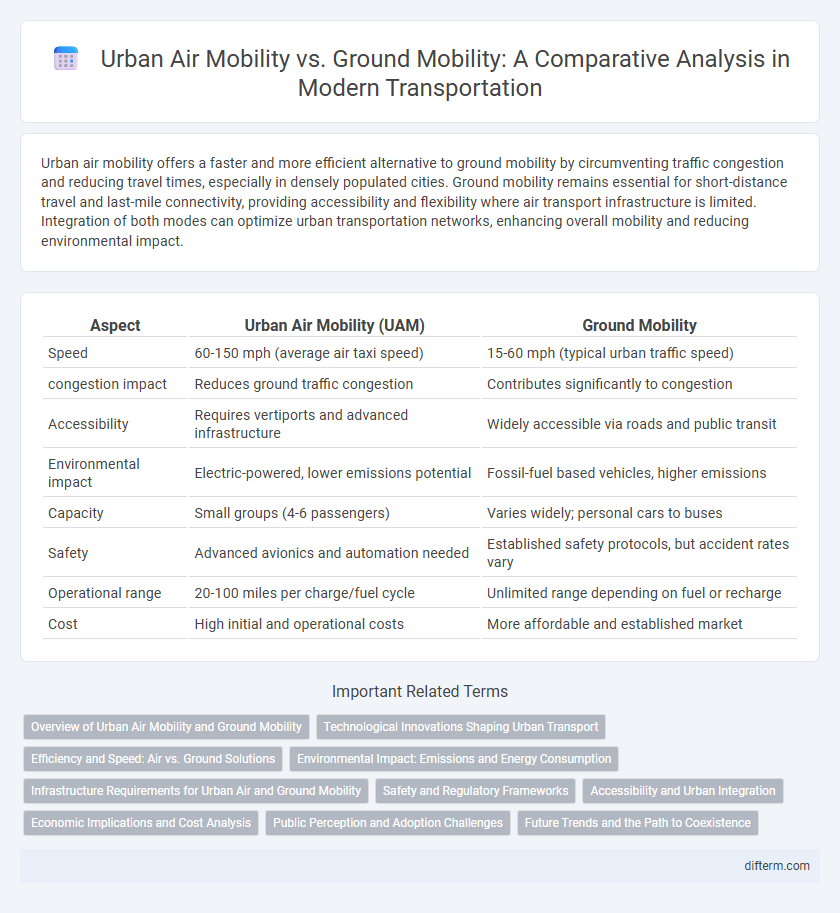Urban air mobility offers a faster and more efficient alternative to ground mobility by circumventing traffic congestion and reducing travel times, especially in densely populated cities. Ground mobility remains essential for short-distance travel and last-mile connectivity, providing accessibility and flexibility where air transport infrastructure is limited. Integration of both modes can optimize urban transportation networks, enhancing overall mobility and reducing environmental impact.
Table of Comparison
| Aspect | Urban Air Mobility (UAM) | Ground Mobility |
|---|---|---|
| Speed | 60-150 mph (average air taxi speed) | 15-60 mph (typical urban traffic speed) |
| congestion impact | Reduces ground traffic congestion | Contributes significantly to congestion |
| Accessibility | Requires vertiports and advanced infrastructure | Widely accessible via roads and public transit |
| Environmental impact | Electric-powered, lower emissions potential | Fossil-fuel based vehicles, higher emissions |
| Capacity | Small groups (4-6 passengers) | Varies widely; personal cars to buses |
| Safety | Advanced avionics and automation needed | Established safety protocols, but accident rates vary |
| Operational range | 20-100 miles per charge/fuel cycle | Unlimited range depending on fuel or recharge |
| Cost | High initial and operational costs | More affordable and established market |
Overview of Urban Air Mobility and Ground Mobility
Urban Air Mobility (UAM) leverages electric vertical takeoff and landing (eVTOL) aircraft to offer fast, congestion-free travel within metropolitan areas, significantly reducing commute times compared to traditional ground vehicles. Ground mobility relies on extensive road infrastructure and predominantly internal combustion or electric vehicles, facing challenges such as traffic congestion, infrastructure limitations, and pollution. UAM presents a transformative approach by integrating advanced air traffic management and sustainable technologies to complement and enhance existing urban transportation systems.
Technological Innovations Shaping Urban Transport
Urban air mobility leverages advanced electric vertical takeoff and landing (eVTOL) aircraft, autonomous navigation systems, and real-time traffic management platforms to revolutionize city transportation. Ground mobility innovations emphasize electric vehicles, intelligent traffic grids, and integrated sensor networks that enhance efficiency and reduce emissions. Together, these technological advancements are driving seamless, sustainable urban transport ecosystems.
Efficiency and Speed: Air vs. Ground Solutions
Urban air mobility offers significantly faster transit times compared to traditional ground mobility by bypassing traffic congestion and utilizing direct flight paths. Efficiency gains are notable as electric vertical takeoff and landing (eVTOL) aircraft reduce energy consumption per passenger kilometer compared to cars stuck in traffic. Ground mobility remains advantageous for short-distance travel and cost-effectiveness, but urban air mobility is poised to revolutionize speed and transport efficiency in densely populated cities.
Environmental Impact: Emissions and Energy Consumption
Urban air mobility (UAM) typically generates higher energy consumption per passenger kilometer compared to ground mobility due to current battery limitations and the energy demands of vertical takeoff and landing (VTOL) mechanisms. Ground mobility modes, particularly electric vehicles and public transit, generally produce lower emissions and higher energy efficiency, aided by established infrastructure and grid electricity. However, UAM has the potential to reduce urban congestion, which indirectly lowers overall emissions by decreasing idling and stop-and-go traffic on roads.
Infrastructure Requirements for Urban Air and Ground Mobility
Urban air mobility demands the development of vertiports equipped with charging stations, advanced navigation systems, and air traffic management infrastructure to ensure safe and efficient operations. Ground mobility infrastructure requires extensive road networks, traffic control systems, and maintenance facilities to support vehicles ranging from traditional cars to electric and autonomous models. Integrating smart technologies in both air and ground mobility infrastructures is essential for optimizing traffic flow, reducing congestion, and enhancing overall urban transportation efficiency.
Safety and Regulatory Frameworks
Urban air mobility (UAM) systems prioritize advanced safety protocols, including real-time air traffic monitoring and collision avoidance technologies, surpassing many ground mobility safety measures reliant on traditional infrastructure. Regulatory frameworks for UAM are evolving rapidly, with agencies like the FAA and EASA establishing stringent certification standards, pilot training requirements, and operational guidelines to ensure secure integration into urban airspaces. Ground mobility regulations primarily focus on road safety laws and vehicle standards, whereas UAM demands comprehensive oversight of air traffic management, noise control, and emergency response protocols to mitigate aerial risks.
Accessibility and Urban Integration
Urban air mobility enhances accessibility by bypassing congested ground routes, providing faster point-to-point travel in densely populated areas. Ground mobility benefits from extensive infrastructure networks and is more seamlessly integrated with existing urban environments, supporting widespread access. Effective urban integration of air mobility requires dedicated vertiports and regulatory frameworks to complement ground transportation systems.
Economic Implications and Cost Analysis
Urban air mobility offers potential cost savings by reducing traffic congestion and shortening travel times, which can enhance productivity and lower operational expenses for businesses. However, initial infrastructure investments and regulatory compliance for air mobility systems remain significantly higher than traditional ground transportation. Ground mobility benefits from established networks and lower upfront costs but faces increasing economic burdens from road maintenance, congestion, and environmental impact.
Public Perception and Adoption Challenges
Urban air mobility faces significant public perception challenges due to safety concerns, noise pollution, and regulatory uncertainties compared to traditional ground mobility. Adoption barriers include infrastructure development, high operational costs, and limited public trust in autonomous aerial vehicles. Ground mobility benefits from established networks and familiarity, making it more readily accepted by the public despite congestion issues.
Future Trends and the Path to Coexistence
Urban air mobility (UAM) is poised to complement ground mobility by reducing congestion through efficient vertical takeoff and landing (VTOL) vehicles that integrate seamlessly with existing transportation networks. Future trends indicate advancements in battery technology, autonomous flight systems, and smart air traffic management will enable safe, scalable, and cost-effective urban aerial transit. The path to coexistence emphasizes regulatory frameworks, infrastructure development, and multimodal connectivity to ensure that UAM enhances rather than competes with ground-based transportation options.
urban air mobility vs ground mobility Infographic

 difterm.com
difterm.com